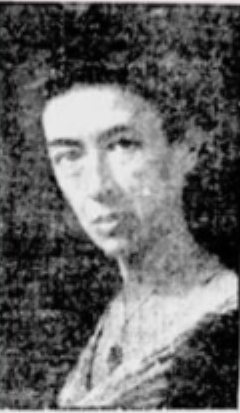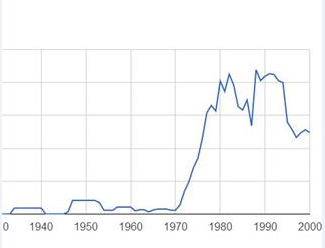Much has been written about the first women doctors of Canada, and especially Ontario’s Emily Howard Stowe, the first woman to practice medicine in Canada, and her daughter August Stowe Gullen, Canada’s female first medical school graduate.
In fact, Maclean’s magazine did a feature on Stowe and Canada’s women doctors way back in 1910. The pioneer feminist rose to fame in Canada in the 1970’s as this Google ngram clearly reveals.
Relatively little has been written about Montreal’s first woman doctor, Octavia Grace Ritchie England. In fact, if you enter her name into google ngrams you get a big fat blank.
Born in 1868 in Quebec’s Eastern Townships, Dr. Octavia Grace Ritchie England was among the first female graduates of McGill, the Donaldas, named after their benefactor, Donald Smith or Lord Strathcona, and it is easy to see what “sparked” this woman to get a science education: social justice.
The daughter of a lawyer, Thomas Ritchie, and youngest of seven children, Grace Ritchie first campaigned for women to be allowed into at McGill University, a very conservative institution that was behind the times in this regard.
She was successful!
Then she fought for women to be allowed in the prestigious medical faculty. Here she was not so successful: that took another 40 years.
But Miss Ritchie did not let that deter her. She ended up getting her medical degree at Bishop’s University in Lennoxville, Quebec with further study in Vienna and Paris.
She put this learning to good use the rest of her life, first as a practising gynecologist and afterwards as a prominent social reformer – and, it should be noted, a social reformer with uncommon guts.
Graduating from McGill first in her class in 1888, Grace Ritchie was chosen to present the women’s valedictory speech. In her speech, she defied the President of the university, Sir William Dawson, who had wanted a key part cut out.
Ritchie dared say these lines while staring Dawson in the face: “The doors of McGill were opened to women four years ago. Those of Medicine still remain closed. When will they be opened?”
She was only 20 years old.
This speech set the tone for Ritchie’s fearless and caring career, where she always stood firm to her principles, even when most other people didn’t.
The 1910 Canadian Who’s Who says Ritchie England took ‘first class honours in Natural Science in addition to her B.A.’, but that is deceptive.
In 1910, the Bachelor of Arts program at McGill was crammed with what we see today as science classes. Back then to earn your BA you had to take mathematics, geology and botany, chemistry, and physics etc.
It is likely Richie England took more courses in Natural Science than was needed to earn her BA.
She set up gynecology practice in Montreal (a rare thing for graduated women doctors who were often forced to work far away from home as missionaries) but gave that up somewhere along the long, possibly when she married and had a daughter.
In 1901 Canadian Census she is listed as having no career. Her husband, Dr. Frank R. England is listed as a medical doctor. But in the 1911 Census she is listed as a medical doctor along with her husband.
(It is interesting to note that in 1911 the England’s paid their cook and maid much more than the going rate on their street.)
During her career, Ritchie also taught anatomy at Bishop’s Medical School and worked as Assistant Gynecologist at Western Hospital.
In 1911, Ritchie England was elected President of the Montreal Council of Women, an umbrella group of 40 social service agencies.
One of her first tasks was to meet militant suffragette Emmeline Pankhurst at the train and to preside over her controversial speech. This was a brave move on her part. Most people in Montreal, even those who wanted women to get the vote, didn’t like Mrs. Pankhurst and her window-smashing ways.
Montreal, Canada’s biggest and most important city in 1910era, also had the highest infant mortality rate in the Western World. Drinking water was often contaminated, resulting in a string of typhoid epidemics that touched everyone – but especially the poor.
Tainted milk was also a pressing problem, so along with their French counterparts, the Montreal Council set up milk stations around the city to teach young mothers how to properly nurse their babies and to provide fresh formula.
At the 1912 Montreal Child Welfare Exhibit, patterned after similar ones in New York and Chicago, Dr. Ritchie England and the Council presided over the housing exhibit.
In those days, many Montreal families lived in back-street tenements, in squalid rooms without clean water, fresh air and sometimes no windows at all! The Council called for an end to this.
Grace Ritchie England showed how much backbone she really had during WWI, when most suffragists and social activists blindly supported Prime Minister Borden’s conscription stance.
In 1917, Borden wanted more men to be drafted into the war- a full 500.000 of them. There were only 8,000,000 people in Canada at the time, so imagine what that meant.
This blind obedience was especially ironic as the Canadian suffragists had always claimed women should be allowed to vote because, unlike men, they were peace-loving and humane.
In this infamous 1917 “Conscription Election” Ritchie-England supported Wilfrid Laurier who wanted a Canada-wide plebiscite before committing to any form of draft.
For sticking to her unpopular principles she was almost impeached in 1918 by the members of the Montreal Council.
It is interesting to note that during WWI the name of the Child Welfare Exhibit was officially changed to Infant Welfare Exhibit. After all, Canadian boys as young as 16 were marching off to war in the trenches in Belgian, with some Canadian women also going overseas to work as VADs or volunteer nurses.
Ritchie England survived her impeachment hearing and continued her social welfare work well into old age. She died in Montreal in 1948.
Canadian women won the right to vote federally in 1920, although women with men killed or active at the war front got to vote in the 1917 election. By then, most provinces already had given the right to vote to women.
In 1922, Ritchie England took a leadership role in the bilingual La Ligue des droits de la femme, that fought for the rights of Quebec women to vote provincially. That didn’t happen until 1940.
In the 1930 Federal election, Ritchie England ran as the Liberal candidate for Mount Royal, in Montreal, saying she hoped to follow in Agnes MacPhail’s footsteps.
She was concerned with the rights of married women, who couldn’t have their own bank accounts or keep their children after a separation or divorce.
However, MacKenzie King’s Liberals lost that election to R.B. Bennett’s Conservatives and a Conservative, Mr. White, was elected to the Mount Royal seat. In his speeches, White referred to his opponent as ‘’a very learned lady.’
Dr. Octavia Grace Ritchie England: Just one of the many Canadian women STEM pioneers who have been largely forgotten by the history books
That is – up until now.
Credits:


